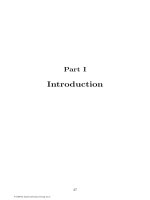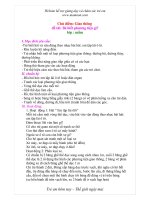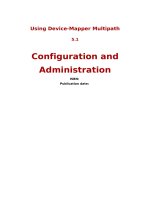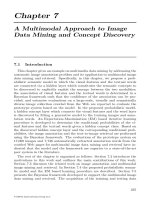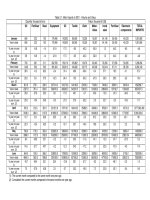Tài liệu AUDITING pptx
Bạn đang xem bản rút gọn của tài liệu. Xem và tải ngay bản đầy đủ của tài liệu tại đây (431.48 KB, 31 trang )
AUDITING
●
Systematic process of objectively obtaining
and evaluating evidence
»
Regarding assertions about economic
actions and events;
»
To ascertain the degree of correspondence
between those assertions and established
criteria; and
»
Communicating the results to interested
users (AAA)
Purpose of an Audit
To provide certain degree of
assurance that the activities
reviewed (financial statements,
operations, management practices,
etc.) have been performed in
accordance with applicable
standards or practices.
Standards on Auditing
●
Either:
International Standards on Auditing,
issued by IFAC (International
Federation of Accountants)
●
or:
Standards for Government Auditors,
issued by INTOSAI (International
Organization of Supreme Audit
Institutions)
AUDIT COMPLIANCE
TYPES OF AUDITS
●
Financial
●
Compliance
●
Operational
FINANCIAL AUDITS
●
The Implementing Organization’s
Financial Statements
●
Project Financial Statements
●
Statements of Expenditures (SOEs)
●
Special Bank Account (SA)
Implementing
Organization’s Financial
Statements
Overall objective is to express an
opinion on fairness of
statements
Phases:
●
Understanding the Organization
●
Evaluating Internal Controls
●
Testing Financial Statement
Balances
Understanding the
Organization
●
Nature of the Organization’s
Activities
●
Organization’s Background
●
Significant Trends and
Relationships
●
Staff Appraisal Report (SAR)
●
Loan Agreement
●
Other Documents Pertaining to
the Project
Evaluating Internal
Controls
●
Purpose: To determine the audit tests
required for forming an opinion
●
How much Reliance on internal controls?
●
Extent of Validation?
»
Tests of Compliance
»
Tests of Transactions
✔
Not an endorsement of the overall
adequacy of the internal control system
Testing the Balances
●
Purpose: To determine if information is
fairly presented
●
Examples:
»
Observation of Inventory-taking
»
Verification of Fixed Assets
»
Direct Verification with Third Parties
✔
Level of Testing Might Depend on
Results from Prior Phases
Audit of Project Financial
Statements
●
Overall Objectives
»
Statements fairly presented?
–
For the period
–
Cumulatively
●
Disbursements made in accordance with:
»
Loan agreement
»
SAR
●
Fair presentation of balance sheets, especially
assets
Audit of Project F/S (cont.)
●
Similar to the audit process for the
entity’s financial statements, except:
»
Greater emphasis on inspection of valid
supporting documentation
»
Additional steps, such as physical observation
of significant items, to substantiate the validity
of expenditures reported.
Audits of SOEs
Primary objective is to ascertain that
individual expenditures reported in
the SOEs are:
●
Fully supported by proper
documentation in files
●
Properly authorized and eligible
●
Appropriately accounted for
Audits of SOEs
Continued
●
Why?
»
Because withdrawal requests are
not supported by documentation
submitted to the Bank
●
Effect?
»
Results of audit are basis for
determining whether to continue
use of SOEs, or if adjustment must
be made on subsequent claims
Audits of Special
Accounts
Primary objectives are to verify that:
●
SA financial statements are fairly
presented, and
●
disbursements from SAs are proper
and in accordance with the
respective loan agreements
Audits of Special
Accounts
(cont.)
●
Auditors should:
»
Review the SA records maintained by
the Implementing Institution
»
Review the SA bank statements
»
Reconcile (including tracking of in-
transit items)
»
Directly confirm balances with Bank
»
Examine treatment and disclosure of
interest earned on SA
Audits of Adjustment Loans
●
Primary focus is on the adequacy of
procedures used to prepare customs or
similar certificates.
●
Limited to examining certificates on
which SOEs have been based and
determining reliability of the procedures
applied in verifying or issuing such
certificates
Audits of Adjustment Loans
(cont.)
●
Important issues:
»
TOR must satisfy financial covenants
»
Documentation must not have been used to
justify another adjustment loan
»
Claims must be properly documented
»
Negative list items must be verified
»
Cut-off dates must be verified
Requirements for Auditors
●
Adherence to principles of integrity,
objectivity, independence and
confidentially
●
Adequate and Competent Staff
●
Work performed by personnel who have
technical training and proficiency
●
Proper direction and supervision of work
(includes quality control)
Selection of Auditors
●
Preferably independent auditors who
meet ISA criteria and are members of
bodies affiliated with IFAC
●
Government audit institutions should
subcontract with audit firms until
equivalent independence and technical
competence is achieved. The Bank can
help them to meet this goal
Determining Auditor
Acceptability
●
TM should consult with an accounting
professional and consider the following:
»
Evidence of independence
»
Qualifications and experience of key personnel
»
Time and personnel reqs. of the audit
»
Experience with:
–
Bank projects
–
Operations similar to the project
»
Peer review, quality control, CPE requirements
of the firm
Government Auditors
●
Usually the “Supreme Audit Institution
(SAI)”
●
Should:
»
Report to legislature, rather than executive
branch of government
»
Have statutory authority
»
Preferably be a member of INTOSAI, and
meet corresponding standards
Contralor
General
Private Sector Auditors
●
Independent auditors who meet ISA
criteria and are members of bodies
affiliated with IFAC
●
Duly licensed to practice the profession
●
Competent staff and adequate facilities
●
Preferably affiliated with an international
firm that provides adequate guidance and
quality control
Appointing the Auditor
●
The borrower appoints the auditor, but
only after the Bank has expressed the
acceptability of the auditor proposed.
●
The auditor should be appointed well
before the beginning of the fiscal year.
Preferably there should be a multi-year
contract.
Terms of Reference (TOR)
●
Provide guidance for the audit and format
of the audit report
●
Should not restrict the auditor’s
obligations with respect to legislation,
regulation, and auditing standards
»
In the event of poor performance, auditors
should not be able to claim that TOR
requirements prevented them from doing
professional work
●
Guidelines & Sample: Annexes 18-19
Additional Guidance
●
“Suggested Minimum Guidelines and Terms
of Reference for the Planning and Execution
of External Audits of Borrowers, Executing
Agencies and Operations Financed by the
World Bank”
●
FM-600 Summarizes Requirements stated in
FM-100, FM-200 and FM-300
